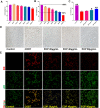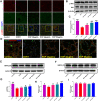Essential oil from the roots of Paeonia lactiflora pall. has protective effect against corticosterone-induced depression in mice via modulation of PI3K/Akt signaling pathway
- PMID: 36188568
- PMCID: PMC9523509
- DOI: 10.3389/fphar.2022.999712
Essential oil from the roots of Paeonia lactiflora pall. has protective effect against corticosterone-induced depression in mice via modulation of PI3K/Akt signaling pathway
Abstract
For thousands of years, the roots of Paeonia lactiflora Pall (PLP) has been considered by traditional Chinese medicine as a drug that can improve mental or emotional disorders, including depression, anxiety and affective disorders. Unfortunately, the research on the mechanism of action and active ingredients of this beneficial drug is not comprehensive. This study focused on the activity of essential oil from PLP (EOP), systematically studied the antidepressant effect of EOP for the first time, and discussed the potential mechanism of its antidepressant effect. In this study, we used a mouse model of corticosterone (CORT)-induced depression, and found that EOP had a significant antidepressant effect on the symptoms of CORT-induced depression in mice, and significantly down-regulated the levels of CRH, ACTH and cortisol in the brain tissues of mice. In addition, we found that EOP treatment alleviated CORT-induced hippocampal neuron injury in mice In vitro experiments. It was also found that EOP could inhibit CORT-induced apoptosis and improve the proliferation ability and cell viability of PC12 cells. Further, with the help of network analysis, it was revealed that PI3K-Akt might be one of the main signaling pathways of EOP against CORT-induced hippocampal neuron apoptosis. In this study, we also found that EOP up-regulated the phosphorylation of PI3K and Akt in CORT-induced mouse hippocampal neurons and PC12 cells, and promoted the nuclear transcription of Nrf2 in CORT-induced PC12 cells. In conclusion, with the integrated approach, we demonstrated that EOP exerted anti-apoptotic effects on hippocampal neurons through PI3K/Akt/Nrf2 signaling pathway.
Keywords: PI3K-Akt pathway; apoptosis; depression; experimental techniques; neuroprotection; oxidative stress.
Copyright © 2022 Sun, Liu, Jiang, Guo, Wu and Yu.
Conflict of interest statement
The authors declare that the research was conducted in the absence of any commercial or financial relationships that could be construed as a potential conflict of interest.
Figures










Similar articles
-
(+)-catechin protects PC12 cells against CORT-induced oxidative stress and pyroptosis through the pathways of PI3K/AKT and Nrf2/HO-1/NF-κB.Front Pharmacol. 2024 Aug 28;15:1450211. doi: 10.3389/fphar.2024.1450211. eCollection 2024. Front Pharmacol. 2024. PMID: 39263574 Free PMC article.
-
Paeonia lactiflora Pall. protects against ANIT-induced cholestasis by activating Nrf2 via PI3K/Akt signaling pathway.Drug Des Devel Ther. 2015 Sep 2;9:5061-74. doi: 10.2147/DDDT.S90030. eCollection 2015. Drug Des Devel Ther. 2015. PMID: 26366057 Free PMC article.
-
Involvement of PI3K/Akt/FoxO3a and PKA/CREB Signaling Pathways in the Protective Effect of Fluoxetine Against Corticosterone-Induced Cytotoxicity in PC12 Cells.J Mol Neurosci. 2016 Aug;59(4):567-78. doi: 10.1007/s12031-016-0779-7. Epub 2016 Jul 13. J Mol Neurosci. 2016. PMID: 27412469
-
Anti-depression effectiveness of essential oil from the fruits of Zanthoxylum bungeanum maxim. on chronic unpredictable mild stress-induced depression behavior in mice.Front Pharmacol. 2022 Sep 20;13:999962. doi: 10.3389/fphar.2022.999962. eCollection 2022. Front Pharmacol. 2022. PMID: 36204228 Free PMC article.
-
Xiaoyaosan ethyl acetate fraction alleviates depression-like behaviors in CUMS mice by promoting hippocampal neurogenesis via modulating the IGF-1Rβ/PI3K/Akt signaling pathway.J Ethnopharmacol. 2022 Apr 24;288:115005. doi: 10.1016/j.jep.2022.115005. Epub 2022 Jan 17. J Ethnopharmacol. 2022. PMID: 35051601
Cited by
-
Network pharmacology combined with experimental verification for exploring the potential mechanism of phellodendrine against depression.Sci Rep. 2025 Jan 14;15(1):1958. doi: 10.1038/s41598-024-84771-9. Sci Rep. 2025. PMID: 39809809 Free PMC article.
-
Real-world observations and impacts of Chinese herbal medicine for migraine: results of a registry-based cohort study.Front Pharmacol. 2024 Feb 2;15:1330589. doi: 10.3389/fphar.2024.1330589. eCollection 2024. Front Pharmacol. 2024. PMID: 38370478 Free PMC article.
-
(+)-catechin protects PC12 cells against CORT-induced oxidative stress and pyroptosis through the pathways of PI3K/AKT and Nrf2/HO-1/NF-κB.Front Pharmacol. 2024 Aug 28;15:1450211. doi: 10.3389/fphar.2024.1450211. eCollection 2024. Front Pharmacol. 2024. PMID: 39263574 Free PMC article.
-
Chronic Corticosterone Administration-Induced Mood Disorders in Laboratory Rodents: Features, Mechanisms, and Research Perspectives.Int J Mol Sci. 2024 Oct 19;25(20):11245. doi: 10.3390/ijms252011245. Int J Mol Sci. 2024. PMID: 39457027 Free PMC article. Review.
-
Antidepressant and anxiolytic potential of Citrus reticulata Blanco essential oil: a network pharmacology and animal model study.Front Pharmacol. 2024 Mar 19;15:1359427. doi: 10.3389/fphar.2024.1359427. eCollection 2024. Front Pharmacol. 2024. PMID: 38567354 Free PMC article.
References
-
- Expert Group of Psychosomatic Medicine Branch of China Association of Chinese Medicine (2021). Expert consensus on clinical application of Shugan Jieyu Capsule in treatment of mild to moderate depressive disorders. J. Beijing Univ. Trad. Chin. Med. 44, 969–977. 10.3969/j.issn.1006-2157.2021.11.002 - DOI
-
- Fan Z. B., Li X. R., Zhu L. F., Bai J., Liang Y. Z. (2012). Analysis of volatile oil from Radix paeoniae Alba by GC-MS and heuristic evolving latent projections. Chin. Med. J. Res. Prac. 26, 19–21. 10.13728/j.1673-6427.2012.02.012 - DOI
LinkOut - more resources
Full Text Sources
Research Materials

